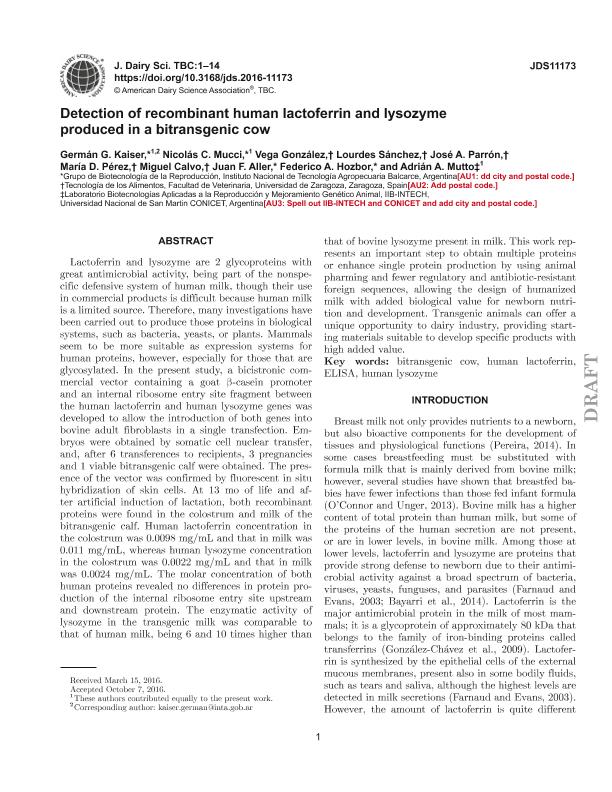Mostrar el registro sencillo del ítem
dc.contributor.author
Kaiser, Germán Gustavo

dc.contributor.author
Mucci, Nicolás Crescencio

dc.contributor.author
González, Vega
dc.contributor.author
Sánchez, Lourdes
dc.contributor.author
Parrón, José A.
dc.contributor.author
Pérez, María D.
dc.contributor.author
Calvo, Miguel
dc.contributor.author
Aller Atucha, Juan Florencio

dc.contributor.author
Hozbor, Federico Andrés

dc.contributor.author
Mutto, Adrián Angel

dc.date.available
2020-04-16T18:00:11Z
dc.date.issued
2017-03
dc.identifier.citation
Kaiser, Germán Gustavo; Mucci, Nicolás Crescencio; González, Vega; Sánchez, Lourdes; Parrón, José A.; et al.; Detection of recombinant human lactoferrin and lysozyme produced in a bitransgenic cow; American Dairy Science Association; Journal of Dairy Science; 100; 3; 3-2017; 1605-1617
dc.identifier.issn
0022-0302
dc.identifier.uri
http://hdl.handle.net/11336/102766
dc.description.abstract
Lactoferrin and lysozyme are 2 glycoproteins with great antimicrobial activity, being part of the nonspecific defensive system of human milk, though their use in commercial products is difficult because human milk is a limited source. Therefore, many investigations have been carried out to produce those proteins in biological systems, such as bacteria, yeasts, or plants. Mammals seem to be more suitable as expression systems for human proteins, however, especially for those that are glycosylated. In the present study, a bicistronic commercial vector containing a goat β-casein promoter and an internal ribosome entry site fragment between the human lactoferrin and human lysozyme genes was developed to allow the introduction of both genes into bovine adult fibroblasts in a single transfection. Embryos were obtained by somatic cell nuclear transfer, and, after 6 transferences to recipients, 3 pregnancies and 1 viable bitransgenic calf were obtained. The presence of the vector was confirmed by fluorescent in situ hybridization of skin cells. At 13 mo of life and after artificial induction of lactation, both recombinant proteins were found in the colostrum and milk of the bitransgenic calf. Human lactoferrin concentration in the colostrum was 0.0098 mg/mL and that in milk was 0.011 mg/mL, whereas human lysozyme concentration in the colostrum was 0.0022 mg/mL and that in milk was 0.0024 mg/mL. The molar concentration of both human proteins revealed no differences in protein production of the internal ribosome entry site upstream and downstream protein. The enzymatic activity of lysozyme in the transgenic milk was comparable to that of human milk, being 6 and 10 times higher than that of bovine lysozyme present in milk. This work represents an important step to obtain multiple proteins or enhance single protein production by using animal pharming and fewer regulatory and antibiotic-resistant foreign sequences, allowing the design of humanized milk with added biological value for newborn nutrition and development. Transgenic animals can offer a unique opportunity to dairy industry, providing starting materials suitable to develop specific products with high added value.
dc.format
application/pdf
dc.language.iso
eng
dc.publisher
American Dairy Science Association

dc.rights
info:eu-repo/semantics/openAccess
dc.rights.uri
https://creativecommons.org/licenses/by-nc-sa/2.5/ar/
dc.subject
HUMAN LACTOFERRIN
dc.subject
RECOMBINANT
dc.subject
BI TRANSGENIC COW
dc.subject
ELISA
dc.subject.classification
Biotecnología Agrícola y Biotecnología Alimentaria

dc.subject.classification
Biotecnología Agropecuaria

dc.subject.classification
CIENCIAS AGRÍCOLAS

dc.title
Detection of recombinant human lactoferrin and lysozyme produced in a bitransgenic cow
dc.type
info:eu-repo/semantics/article
dc.type
info:ar-repo/semantics/artículo
dc.type
info:eu-repo/semantics/publishedVersion
dc.date.updated
2020-04-02T15:16:30Z
dc.journal.volume
100
dc.journal.number
3
dc.journal.pagination
1605-1617
dc.journal.pais
Estados Unidos

dc.description.fil
Fil: Kaiser, Germán Gustavo. Instituto Nacional de Tecnología Agropecuaria. Centro Regional Buenos Aires Sur. Estación Experimental Agropecuaria Balcarce. Laboratorio de Biotecnología de la Reproduccion; Argentina
dc.description.fil
Fil: Mucci, Nicolás Crescencio. Instituto Nacional de Tecnología Agropecuaria. Centro Regional Buenos Aires Sur. Estación Experimental Agropecuaria Balcarce. Laboratorio de Biotecnología de la Reproduccion; Argentina
dc.description.fil
Fil: González, Vega. Universidad de Zaragoza; España
dc.description.fil
Fil: Sánchez, Lourdes. Universidad de Zaragoza; España
dc.description.fil
Fil: Parrón, José A.. Universidad de Zaragoza; España
dc.description.fil
Fil: Pérez, María D.. Universidad de Zaragoza; España
dc.description.fil
Fil: Calvo, Miguel. Universidad de Zaragoza; España
dc.description.fil
Fil: Aller Atucha, Juan Florencio. Instituto Nacional de Tecnología Agropecuaria. Centro Regional Buenos Aires Sur. Estación Experimental Agropecuaria Balcarce. Laboratorio de Biotecnología de la Reproduccion; Argentina
dc.description.fil
Fil: Hozbor, Federico Andrés. Instituto Nacional de Tecnología Agropecuaria. Centro Regional Buenos Aires Sur. Estación Experimental Agropecuaria Balcarce. Laboratorio de Biotecnología de la Reproduccion; Argentina
dc.description.fil
Fil: Mutto, Adrián Angel. Consejo Nacional de Investigaciones Científicas y Técnicas. Centro Científico Tecnológico Conicet - La Plata. Instituto de Investigaciones Biotecnológicas. Universidad Nacional de San Martín. Instituto de Investigaciones Biotecnológicas; Argentina
dc.journal.title
Journal of Dairy Science

dc.relation.alternativeid
info:eu-repo/semantics/altIdentifier/doi/http://dx.doi.org/10.3168/jds.2016-11173
dc.relation.alternativeid
info:eu-repo/semantics/altIdentifier/url/https://www.journalofdairyscience.org/article/S0022-0302(17)30035-8/abstract
Archivos asociados
